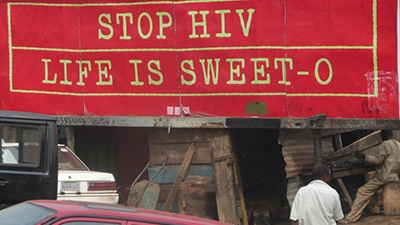July 20, 2012 -Yellow, pink and green are the colors of promise in a country where 3.5 million people live with HIV.
In the suburbs of Abuja, Nigeria, dedicated implementers of HIV programs are meticulously mapping the area’s HIV epidemic with colorful dots, symbolizing the locations of most-at-risk populations. Nationwide, these populations—including female sex workers, injecting drug users and men who have sex with men—comprise about 3.4% of the national population but account for as much as 40% of new infections in the country.
The mapping of these at-risk populations is part of a first-time, nationwide effort supported by the World Bank to track a virus that infects close to 1,000 people a day in the West African country—the second highest number in the world.
The exercise is connecting the dots between health facilities and civil society organizations (CSOs) that provide services—including antiretroviral therapy, HIV counseling and therapy, and prevention of mother-to-child transmission (PMTCT) of HIV—and the most at-risk populations. It is also calculating the size of these populations, where they operate and their behaviors, which will expose programmatic gaps and help improve the design, implementation and evaluation of programs to prevent infections.
The task is daunting: Abuja, the Federal Capital Territory (FCT), is just one of more than 30 areas across the country that state agencies are mapping. The FCT Agency for the Control of AIDS is mapping 1,560 locations where female sex workers work, 116 linked to men who have sex with men and 43 linked to injecting drug users.
“We took this approach because we knew resources for HIV were limited,” says Uche Okoro, Program Manager for the FCT Agency for the Control of HIV/AIDS. “We wanted our programs for these populations to be based on facts.”
Big challenges, big investments
A quarter-century has passed since the first case of HIV was diagnosed in Nigeria. Before 2000, advocates, agencies and partners tried to keep pace with the deadly disease, but fell short in the absence of national coordination and detailed data that told the true story of the epidemic.
In 1999, Nigeria’s president moved HIV/AIDS to the top of the country’s agenda and a year later, created the National Action Committee on AIDS, which later became an agency. The same year, the World Bank scaled up its support to countries to improve the efficiency, effectiveness and sustainability of their national AIDS responses. Since then, the World Bank has committed $2 billion to 33 African countries—including $366 million toward HIV prevention efforts in Nigeria—and four regional, cross-border projects in Africa to expand national HIV/AIDS efforts.
Nigeria’s five-year strategic HIV/AIDS plan (2010-2015) is focusing on prevention for those most at risk (and including PMTCT), expanding access to treatment, and improving strategic knowledge and management of the epidemic to inform implementation programs. With less than one in five HIV-positive women with access to PMTCT services, and with only limited coverage of most at-risk populations, strengthening or establishing local and state AIDS control agencies and CSOs playing key roles in information and service delivery is essential to saving millions of lives.

